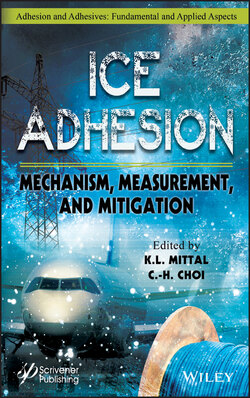Читать книгу Ice Adhesion - Группа авторов - Страница 36
2.2.1.2 Homogeneous Ice Nucleation in Supercooled Water
ОглавлениеThe major difference between homogeneous nucleation of ice from supercooled liquid water and from supersaturated vapor lies in the growth mechanism of the ice nucleus. As the water molecules are already in contact with the ice nucleus in supercooled water, the nucleus growth involves the reorientation of water molecules. Matsumoto et al. suggested that a sufficient number of relatively long-lived hydrogen bonds is required to develop spontaneously at the same location to form a compact initial ice nucleus [84]. During this process, the molecule needs to pass from the original equilibrium position in water to a new equilibrium position in ice. The energy barrier ∆F between the two positions is the molar Gibbs free energy for activating the diffusion of water molecules across the water-ice embryo interface. This energy barrier ∆F therefore leads to the expression for the diffusive flux,
(2.9)
where h is Planck constant and Nc is the number of water molecules in contact with a unit area of ice embryo surface. NA is the Avogadro constant. By replacing w↓ in Eq. 2.7 with the homogeneous ice nucleation rate in the supercooled water can be written in an analogous form,
(2.10)
The homogeneous ice nucleation in supercooled water droplets is regarded as the controlling mechanism for the cirrus cloud formation in the atmosphere. In the past decades, the ice nucleus has been considered to form in the volume of supercooled droplets. However, recent studies reveal that the homogeneous ice nucleation initiating from the droplet surface should not be disregarded [9-11]. Tabazadeh et al. suggest that the total ice nucleation rate Jtotal in atmosphere should consist of both volume (Jv) and surface based rate (Js), Jtotal = JvV + JsS, where V and S are the volume and surface area of supercooled droplet in a unit volume of air, respectively [9]. It suggests that if the nucleation energy barrier at the droplet surface is significantly lower than that in the volume, the surface nucleation is favored over volume nucleation. Such competition between surface and volume nucleation also appears in scenarios of droplet icing on surfaces [31]. Jung et al. experimentally validated that the evaporative cooling of a supercooled droplet induced the homogeneous ice nucleation at the air-droplet interface rather than the expected heterogeneous nucleation at the solid surface [25] (see Figure 2.2). Similarly, Ehre et al. also reported that a positively charged pyroelectric surface initiated the heterogeneous ice nucleation at the solid-water interface of a deposited droplet, whereas a negatively charged surface can trigger the homogeneous ice nucleation at the air-droplet interface [72].
Figure 2.2 Snapshots (at 6ms interval) showing the ice nucleation of a 5µl droplet on a superhydrophobic surface in an unsaturated nitrogen flow field (N2 flow direction from left to right). The origin and direction of white arrows denote the instantaneous position and direction of motion of the freezing front, respectively. Figure is reprinted with permission from [25].
